

Home Page |
MICHIGAN FORESTS FOREVER TEACHERS GUIDE
 |
Big Energy Picture |
|
Wood Energy Curriculum for High School Classrooms
This wood energy curriculum module is divided into five sections. Each section has a set of exploration topics to help guide students through an aspect of energy, energy use, and the role of woody biomass. Some materials are provided but, more important, resources are included for development of additional materials.
1 - Big Energy
2 - Wood Energy
3 - Environmental Aspects
4 - Socio-Economic Aspects
5 - Bringing It All Home
The Big Energy Picture
OK, energy is important. We hear a lot about it in the news. When energy prices go up, we hear a lot of people complain.
Energy is a commodity that we don’t often think about. It simply comes to us for a certain price, or simply comes to us and we don’t even think about the price (how much is your monthly electric bill?). And, price is just one aspect to energy. Energy is a product that has to be manufactured from raw materials. All usable energy comes to us at an energy cost, as well as other costs. We use a tremendous amount of energy; therefore we use a tremendous amount of raw materials. Americans use more energy per person than just about anywhere in the world.
Like any manufactured product, energy needs raw materials, which must undergo extraction and collecting, some sort of processing (value-added), and then needs to be marketed and distributed. The energy industry has many pathways and quickly becomes complex. Because it is so essential to almost everything we do and possess, this industry is highly regulated and subsidized. There are huge economic and social implications. There are also huge environmental and political effects. Energy is a driver in global welfare, with both good and bad effects.
How might our consumption of gasoline impact a poor family in Mexico?
When we plug something into an electric outlet, does that threaten pronghorn antelope in Wyoming? Or clean water in West Virginia? Or polar bears in the Arctic?
As we crank-up the thermostat, how many hundreds of miles did that natural gas pipeline run through?
How do renewable energy technologies compare to conventional technologies?
In what way might the energy industry, upon which our lives depend, affect global climate? Social justice? United States independence? Rural economies?
There are many energy questions that have real-life implications to things we all care about, or at least impact us in significant ways. Beginning in the 1850s, the world has increasingly grown dependent upon fossil fuels for energy. By the time you have grandchildren, the world will have a very different energy economy from that which we are now familiar. It might be difficult to predict what that economy will look like, but there is little doubt that it will be much different than today. Alan Kay [http://www.ecotopia.com/webpress/futures.htm] has a good quote that applies to this idea; “The best way to predict the future is to invent it.”
This first section explores answers to 10 questions. These ten questions will likely generate other questions, which would be good to explore.
1. What are fossil fuel sources of energy?
2. What are non-fossil fuel sources of energy?
3. In what ways is energy used today in the USA?
5. Where does the USA obtain its energy feedstocks? How much is domestic?
6. From what fuel sources does Michigan currently derive energy from?
7. What is the relationship between reducing energy consumption vs. new energy plantations?
8. Does conservation and efficiency mean going without choices?
10. Which countries have more advanced renewable energy?
Question 1. What are fossil fuel sources of energy?
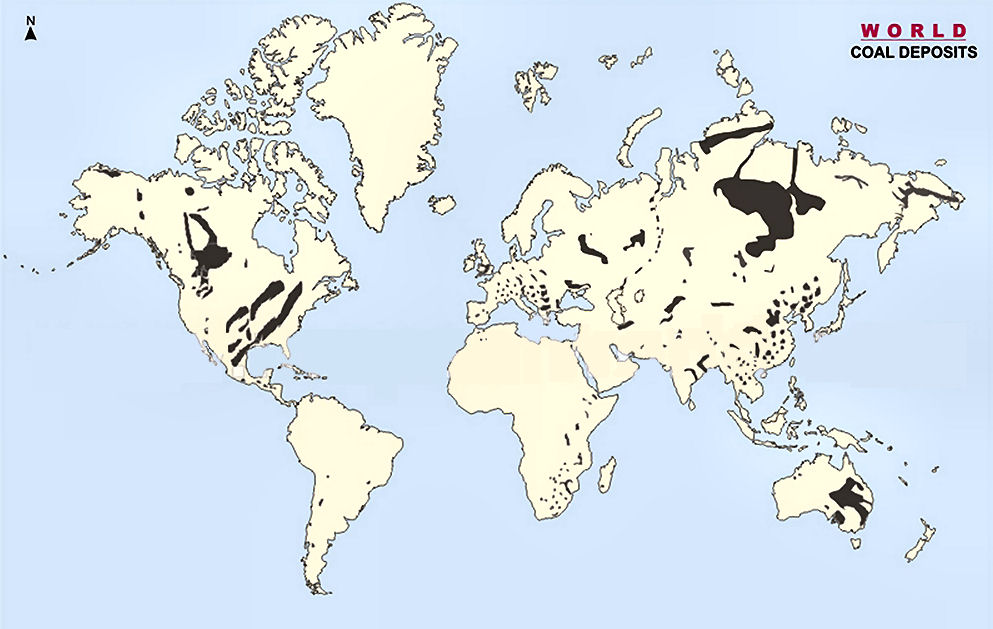 World Coal Deposits [Source: Maps of the World] |
Fossil fuels are
those derived from living things, mostly plants, from millions of years ago.
The energy originated from the sun, was trapped by plants, and developed
underground into coal, petroleum, and natural gas. Extraction of fossil fuels
comes with environmental and human costs. This is true of all energy
sources. However, we sometimes don’t consider the costs of fossil fuel
extraction when we think about similar costs associated with renewable
technologies. There are also different qualities and forms of coal,
petroleum, and natural gas. The locations of deposits (e.g. under the
ocean, tar sands, deep underground) affect their accessibility and cost.
Try to imagine that we lived from some unknown energy source that was running scarce, and scientists were attempting to convince society of the value of fossil fuels. It's abundant but we'll need to construct thousands of miles of pipelines and dozens of multi-billion dollar refineries. Then, we'll have to assemble a distribution system consisting of millions of miles of copper wire and many thousands of refueling stations. We'll need to create billions in businesses that manufacture, service, and dispose of equipment and machinery. We'll need to be careful because gasoline and natural gas are extremely flammable. Vehicles will run on explosive fuel. We'll need to transport these raw materials around the world. Mountains will need to be torn down. Billions of tons of carbon dioxide will need to be released, which might change our climate in some uncertain way. Complex global structures must be emplaced and there will be the risk of political instability and maybe even war. Now, try to sell this system to the public.
Fossil fuels contain carbon and other chemical components (e.g. heavy metals) that are increasingly becoming a concern with our atmosphere, food sources, human health, and other areas of concern. Atmospheric carbon levels and global climate change are on the news forefront.
Fossil fuels re-introduce vast quantities of carbon that have long been stored under the ground. This carbon, and other chemicals, has accumulated in the atmosphere. These atmospheric changes are causing and/or contributing to changes in the world’s climate patterns. While this topic is controversial, most of the scientists that research global climate now agree that human-caused fossil fuel combustion represents a threat to human safety and welfare. This issue is one reason driving the interest in renewable energy technologies and increased efficiencies and conservation.
Fossil fuels are also a finite resource, meaning once used they cannot be replaced. Shortages in cheap fossil fuels, that are economically accessible, will cause instability in energy prices. Unstable energy prices have important impacts to world economies, especially those of lesser developed countries. The fossil fuel of greatest concern, likely the first to become more scarce, is petroleum. The price of gasoline at the pump is the most obvious indicator.
Distribution of Fossil Fuels by Global Regions |
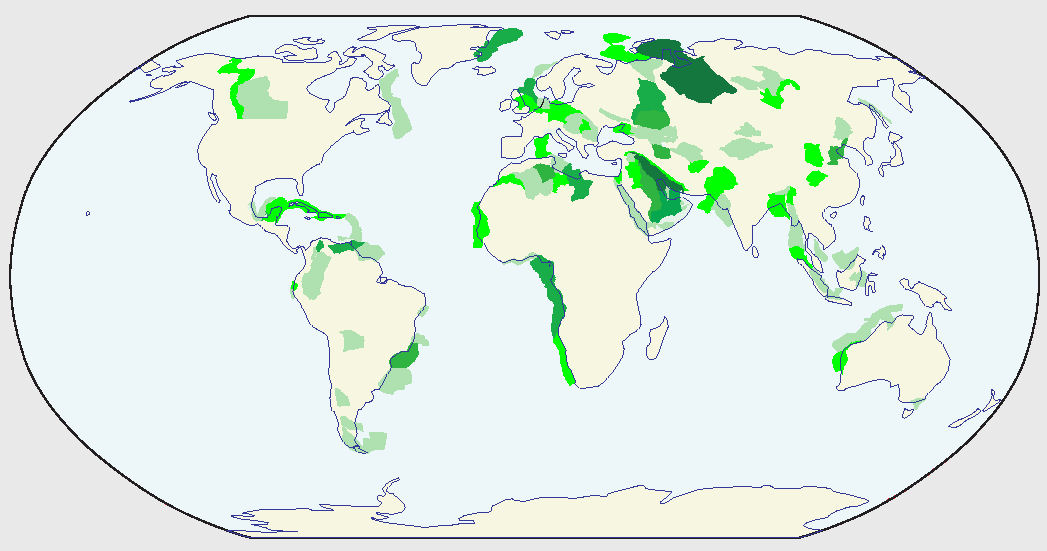 Known Petroleum Deposits [Source: U.S. Geological Survey] |
|
|
Global Natural Gas Deposits [Source: IndexMundi.com] |
What arguments are made against global climate change? How credible are those sources?
How larger are current world reserves of oil, coal, and natural gas?
What proportion of those reserves are considered easily accessible?
How has economic growth in China, India, and Indonesia affected demand for fossil fuels? What’s the 20 year outlook?
References
Question 2. What are non-fossil fuel sources of energy?
Non-fossil fuels are everything else, including hydro, wind, solar, geothermal, biogas, and biomass. Some people place nuclear power in this category, too. All of these technologies will be important as our energy economy changes and moves away from fossil fuel consumption. Some of these technologies have been around a long time. How do home electric prices in Washington State (Grand Coulee dam) compare to those in the U.P. (mostly coal power)?
Each has advantages and disadvantages. Wind works only when the wind blows and electricity is a challenge to store for when it’s needed. Solar requires huge amounts of area, efficiencies are low (but improving), and doesn’t work well in parts of the country. Solar also uses large amounts of rare metals and other materials. Wood involves the transportation of high volume / low value materials and cutting trees is not everywhere socially acceptable.
The term biofuel is often used to describe all or a portion of renewable energy feedstocks that come from plant resources. It might also be used to describe a processed fuel, such as ethanol or methane. This can lead to confusion in conversations. Ethanol made from corn (or other starch sources, such as sugar cane or grains) has generated debate in the media and government policy. Ethanol can also be made from "cellulosic" feedstocks, such as wood and non-starch vegetable matter (e.g. corn stover or bagasse from rice or sugar cane). Cellulose is a structurally complex molecule that is more difficult to break apart, and then re-assemble, than starch molecules. These processing technologies are on the high end of the cost and complexity spectrum. The proposed cellulosic ethanol plant in Kinross (eastern U.P.) is one of the facilities striving to become the first commercial cellulosic ethanol plant in the world.
On the other hand, wood energy applications for district energy and combined heat & power plants is on the lower end of the engineering scale. These technologies have been deployed widely around the world and some exist in Michigan. They are particularly practical in forest-rich areas.
Take some time to explore differences among the various renewable technologies. There are some that are not mentioned here (e.g. industrial algae), and you will probably be able to think of other ways to compare the various sources of renewable energy.
Comparison |
Hydro |
Wind |
Solar |
Geothermal |
Biogas |
Wood Biomass |
Other Biomass |
Fuel Source |
Gravity |
Wind |
Sun |
Ground Heat |
Agricultural |
Forests, Plantations |
Agriculture, MSW,* Demo Wood* |
Availability |
Always |
Irregular |
Daytime |
Always |
Local |
Always |
Irregular |
Technology Readiness |
Yes |
Partly |
Partly |
Yes |
Yes |
Yes & No |
Yes & No |
Initial Cost |
High |
High |
High |
High |
Medium |
Medium |
Medium |
Operating Cost |
Low |
Medium |
Low |
Low |
??? |
Low |
Low |
??? |
|
|
|
|
|
|
|
|
??? |
* "MSW" = Municipal Solid Waste and "Demo Wood" is wood from demolished buildings and similar sources.
Question 3. In what ways is energy used today in the USA?
What kinds of energy do we use? Can all the hundreds (thousands?) of uses be grouped into a few categories that make sense?
Essentially, humans use energy in one of three fundamental ways; to heat & cool spaces, to generate electricity, and as transportation fuel. The U.S. Energy Information Administration collects national energy data [http://www.eia.doe.gov]. Those data yield a pretty good picture on the national level, by states, and internationally. For example, the USA uses more energy than any country in the world (and all of Europe), but on a per capita basis, the USA ranks #15 out of over 230. Canadians use more energy per capita than people in the USA.
The different purposes for which energy is used is important because not all fuels are equally applicable to all purposes. For example, most electricity comes from coal and most space heating is done with natural gas. Petroleum is used mainly for transportation fuel; coal for electricity generation. Wood can be most easily applied to heating and cooling buildings. Emerging technologies will soon be producing ethanol and biodiesel from wood, for transportation fuels. Nuclear or wind energy will not fuel your car (unless you have an electric car), but it can run all the electric appliances in your house.
Sample Graphs
Bar Chart-Fuel Sources by
End Use Sector, USA, 2008 (trillion BTUs)
[Source: Energy Information Administration, http://www.eia.gov]
(Click for larger image)
[Bioeconomy/Spreadsheets/ConsumptionUSA2008.xls] [Sector-Fuel tab]
Bar Chart-Electricity
Capacity by Energy Source, USA, 2009 (megawatts)
[Source: Energy Information Administration, http://www.eia.gov]
(Click for larger image)
[Bioeconomy/Spreadsheets/ElecCap-EnergySource2009.xls]
Pie Chart-Energy
Consumption, USA, by End Use Sector, 2008 (trillion BTUs).
[Source: Energy Information Administration, http://www.eia.gov]
(Click
for larger image)
[Bioeconomy/Spreadsheets/ConsumptionUSA2008.xls] [graphs
tab, bottom]
Question 4. How much energy do we use in the United Stated? In Michigan?
How does
this compare to use in developing countries? China? Indonesia? India?
In the USA, we consume about 100 quadrillion BTUs each year. That’s a number with a LOT of zeroes.
100,000,000,000,000,000
In Michigan, we use about 3 quadrillion BTUs each year. That’s enough to place six 100 watt light bulbs in every square foot of the state. Or . . . run an average home furnace for 3.4 million years. Or . . . drive 600 billion miles in a 25 mpg car (about 80 round trips to Pluto).
The United States ranks #1 among countries regions of the World in total energy consumption. We use more than all of Europe, combined. More than any other continent.. However, a more equitable comparison is per capita energy use. The USA uses a lot of energy, but we also have over 300 million people. On a per capita basis, the USA ranks #15 – still a major energy user. The USA uses a lot of energy, and we make a lot of stuff. Our Gross Domestic Product (GDP), the value of all the goods and services produced in a country, was $14.5 trillion in 2010. [IMF] However, all that stuff comes with a huge energy cost.
The amount of energy consumed is important. Its production comes with monetary, environmental, and socio-cultural costs. Consuming less energy is generally considered a good thing, but this does not have to mean reduced lifestyles for citizens. Efficiency and conservation measures, if fully employed, could drastically reduce energy consumption with minimal lifestyle change. It's more about being "smarter" than "doing without". Additionally, consuming less energy will likely extend current fossil fuel supplies, help stabilize consumer costs of energy (e.g. gas prices), reduce greenhouse gas emissions (e.g. CO2), allow more time to develop renewable energy technologies, and increase energy independence.
Energy consumed is not the same as the energy contained within various feedstocks. “Consumed” means the actual BTUs (or other energy unit) used by various sectors: industrial, transportation, commercial, and residential. It’s what you and I actually use. It is a lower figure than the amount of energy “produced” from different kinds of power plants and refineries. Some of the energy produced never makes it to the end user. And, the energy produced is a much lower figure than the energy within various feedstocks that were used to produce energy products. For example, a ton of coal has 16-20 million BTUs. In many coal-burning power plants, that employ decades-old technology, about 60-75% of the energy goes up the smokestacks, unused. The remaining energy is converted to electricity. Moving that electricity over the wire grid results in a loss of 2-7%. Tremendous waste exists within the energy sector.
There are a number ways to explore the abundance of energy data available through the Energy Information Administration and many other sources. Of course, understanding the definitions and implications of terms is important, and consideration of particular biases that some sources might present. Below are some samples of graphic illustrations that might help someone better understand an aspect of some of the "big energy" pictures.
Bar Chart-Per Capita
Energy Consumption in USA By State, 2008.
[Source: Energy Information Administration, http://www.eia.gov]
(Click
for larger image)
[Bioeconomy/Spreadsheets/ConsumptionUSA2008.xls] [graphs tab]

Total Energy Consumption, Top 20 Regions and Countries, 2008.
[Source: Energy Information Administration, http://www.eia.gov]
(Click
for larger image)
[Bioeconomy/Spreadsheets/ConsumptionIntl2008.xls] [graphs tab]
Per Capita Energy
Consumption, Top 20 Regions and Countries, 2008.
[Source: Energy Information Administration, http://www.eia.gov]
(Click
for larger image)
[Bioeconomy/Spreadsheets/ConsumptionIntl2008.xls] [graphs tab]
United States Energy Use Trends 1774-2009.
[Source: Energy Information Administration, http://www.eia.gov]
(Click
for larger image)
[Source: http://tonto.eia.doe.gov/aer/pdf/perspectives_2009.pdf]
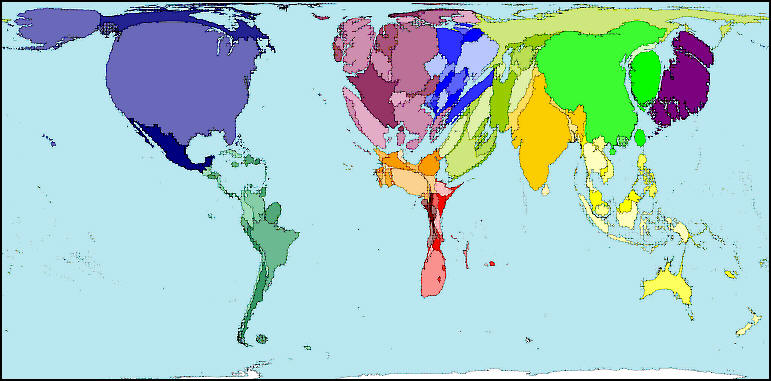
Fuel Use, includes gas, coal, oil, nuclear, wood, and other materials. [PDF poster]
Territory size is proportional to the percentage of world fuel usage that occurs there.
From . . . Worldmapper Cartogram [http://www.worldmapper.org]
© Copyright SASI Group (University of Sheffield) and Mark Newman (University of Michigan).
Pie Chart-Percent of
World GDP, 2009.
[Source: Energy Information Administration, http://www.eia.gov]
(Click
for larger image)
[Bioeconomy/Spreadsheets/Consumption-GDP-BTU.xls] [second tab]
Question 5. Where does the USA obtain its energy feedstocks? How much is domestic?
Most energy in the USA comes from oil, natural gas, and coal. Nuclear and hydro power is significant in some regions. Renewable energy makes up about 8 percent, with most of that from biomass. Michigan is one of the largest woody biomass consumers in the nation.
“Biomass today accounts for five times the energy production of solar and wind combined and the forest products industry is responsible for 75 percent of that. Biomass power is available even at night or when the wind is not blowing – an advantage not to overlook.” – Dr. Dale Greene, professor of forest operations in the Center for Forest Business, Warnell School of Forestry & Natural Resources, University of Georgia, Athens.
The charts and other information from the first question can also be used to help answer this question. That’s because the energy sources are linked to the energy uses. Questions can be asked from either end (and some from in between!).
Most of the energy we use in the USA comes from domestic sources. We import about 30% of our energy from other countries. That amount has increased significantly over the past 50 years. Where do you think most of our oil imports come from? Saudi Arabia? Actually the two largest oil importers into the USA are Canada and Mexico. Venezuela is number 3, and then Saudi Arabia. It’s a good thing we have friendly relationships with most of our largest importers. Of course, this is where much of our “oil politics” come from. |
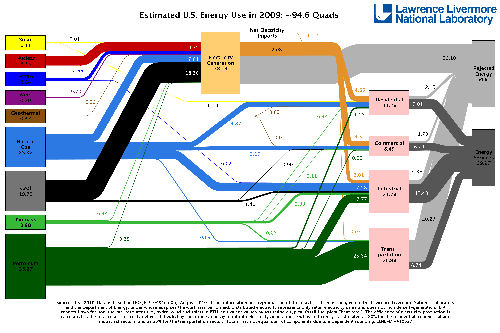
Click on the flow chart to see a higher resolution copy. |
Bar Chart-Use of Energy
Sources, USA, 2008 (trillion BTUs).
[Source: Energy Information Administration, http://www.eia.gov]
(Click
for larger image)
[Bioeconomy/Spreadsheets/ConsumptionUSA2008.xls] [sector-fuel tab]
EIA Graphic-Role of
Renewable Energy in the Nation’s Energy Supply, 2009.
(Click
for larger image)
Energy Sources, USA,
2008-2010 (quad BTUs).
[Source: Energy Information Administration, http://www.eia.gov]
(Click
for larger image)
[Bioeconomy/Spreadsheets/EIA2010-ConsBySectorSource.xls]
Area Chart-Energy
Production & Consumption, USA, 1980-2010 (imports).
[Source: Energy Information Administration, http://www.eia.gov]
(Click
for larger image)
[Bioeconomy/Spreadsheets/Imports-1980-2035.xls]
Area Chart-Percent of
Energy Imports, USA, 1960-2004.
[Source: Energy Information Administration, http://www.eia.gov]
(Click
for larger image)
[Bioeconomy/Spreadsheets/ImportsEnergyCountry.xls] [TimeSeriesUSA tab]
Bar Chart-Top Ten Oil
Importers to the USA, 2005.
[Source: Energy Information Administration, http://www.eia.gov]
(Click
for larger image)
[Bioeconomy/Spreadsheets/ImportsEnergyCountry.xls] [Oil Imports tab]
Area Chart-U.S. Oil
Production & Imports 1860-2009.
[Source: Energy Information Administration, http://www.eia.gov]
(Click
for larger image)
[Bioeconomy/Spreadsheets/OIL.xls]
Question 6. From what fuel sources does Michigan currently derive energy from?
Michigan ranks #10 among U.S. states in total energy consumption (EIA, year 2008). Oil is our leading source of energy, closely followed by coal and natural gas. Renewable energy comprises about 5 percent. Biomass makes up about 3 percent and most of that is produced and used by the forest industry. Michigan has about 125 wood-burning boilers that require air quality permits. [Cite 1] This does not include all the wood burning fireplaces, home furnaces, and outdoor wood stoves.
Over the last few years, Michigan paid out around $25-30 billion dollars for energy. That’s about 7-10 percent of Michigan’s Gross Domestic Product (GDP). An argument can be made that keeping some of that money inside the state would help Michigan’s economy.
Quick Facts from the EIA [http://www.eia.gov/state/state_energy_profiles.cfm?sid=MI]
Michigan has more natural gas reserves than any other State in the Great Lakes region.
The Antrim natural gas fields, in the northern Lower Peninsula, are among the largest in the Nation.
Michigan has the most underground natural gas storage capacity of any State in the Nation and supplies natural gas to neighboring States during high-demand winter months.
Michigan is a substantial generator of electricity from wood and wood waste.
Natural gas heats roughly four-fifths of Michigan homes.
Two renewable energy technology manufacturers plan to transform an abandoned automobile factory in Wixom to the Nation’s largest renewable energy park, producing solar panels and large-scale batteries to store power for the electric grid.
Pie Chart – Energy Consumption by Source,
Michigan, 2008.
[Source: Energy Information Administration, http://www.eia.gov]
(Click
for larger image)
[Bioeconomy/Spreadsheets/ConsumptionState.xls] [2008T tab]
References
Southeast Michigan Resource Conservation & Development. 2007. Exploring Woody Biomass Retrofit Opportunities In Michigan Boiler Operations.
Question 7. What is the relationship between reducing energy consumption vs. new energy production?
If all the cited benefits of reducing fossil fuel use are to be realized, there must be more to the discussion than simply swapping renewables for fossil fuels. Renewable technologies simply do not have the capacity to meet today’s energy demand (unless nuclear is included), let alone future demand, which is expected to increase. If the potential was achieved for wind, solar, and biomass, that amount would only satisfy about a third of Michigan’s demand.
Discussions about future energy economies need to consider the reduction of demand, as well as introducing renewable technologies to the supply. In the media, supply-side news is covered far more frequently than the demand-side, even though the potential savings are greater on the demand-side.
Consumption of fossil fuels can be substantially reduced through conservation and efficiency. Some of these changes will save consumers money. Of course, some of these changes will result in increased energy costs, which is a major socio-political barrier in this country (less so in other countries). People don’t want to pay more for energy, even if the true costs are extracted from the environment or damage lifestyles in other countries. In the long run, the future generations may be the people who pay the costs by reduced opportunity.
Conservation involves using natural resources wisely. For example, most of the electricity production in Michigan is derived from coal. Much of the energy in coal is wasted. The heat generated is considered a waste product and the combustion technology is not particularly efficient. Only about 30-40 percent of the energy in a ton of coal is successfully converted into electricity. Better combustion technologies might raise the efficiency to 50 to 60 percent. Theoretically, existing technologies can capture that "waste" heat and use it for building heating and cooling. This is commonly done in many European countries, where the power plants are located near the consumers. This is not the geographical situation in North America. |
 Renewable Energy Wedges Combine to Reduce Non-Renewable Energy Use. Adapted from Socolow & Pacawa, 2004. (Click for larger image) The basic idea of this "wedge" concept is to breakdown the monumental issue of reducing fossil fuel consumption. The red line is an unsustainable trajectory into the future. The white dashed is where fossil fuel consumption will go, either by choice or by necessity. The large triangle between the red arrow and the dashed line is where innovation must occur. Each "wedge" within that triangle represents a collection of concepts and technologies. Additional wedges can be added. Many experts agree that the "conservation and efficiency wedges" offer the greatest opportunities. However, the target goals will not be met without the contributions from all wedges. These "wedge diagrams" are used to help illustrate the big picture in a simplified manner. |
Question 8. Does conservation and efficiency mean going without choices?
Some people believe austerity (going without things) is the result of conservation and efficiency. This simply does not have to be so.
Buying a new car might serve as a good example. Transportation is very expensive. Owning and using a car will cost thousands of dollar per year. But how can these costs be minimized without simply parking the car?
In the United States, we tend to buy what is cheapest. We have the habit of spending less money up-front, even if it costs us more in the long-run. We don't often enough think about the long-run. If American purchasing behavior changed to consider the total cost of something, then the value of efficiency and lower energy use would become more important, and significant reductions in energy use could be realized.
Time to build a spreadsheet to examine costs over a 10 year period. Pick two similar vehicles, say a Ford Echo and a VW Jetta TDI (diesel). Figure all the annual costs; 10% of purchase price, insurance, maintenance allowance, and fuel for 15,000 miles. Which vehicle is cheaper in the long run? Which vehicle has a higher up-front cost? Compare the costs of a small wagon to a Dodge 3500 pickup or Chevy Yukon. These are very different vehicles. Once you know the cost of the big Dodge or SUV . . . are you still willing pay for the difference? Maybe so, but at least now you have made a more informed choice.
How much fuel might be saved in a year if 50 million people went from 20 mpg to 40 mpg?
Try this same evaluation process with home appliances, such as water heaters, clothes dryers, furnaces, or refrigerators. You can obtain the data from local stores or on-line. New houses are often built without energy efficient considerations because these considerations cost more money. However, in the long run, a well-designed and constructed home will save the homeowner thousands upon thousands of dollars over the “cheap” house.
The long-term cost differences of various products are usually the differences in energy consumption. Americans tend to not consider energy consumption in their purchasing behavior because energy has been relatively cheap and has been a somewhat hidden cost. Energy costs are rising but there are still many hidden costs.
There are studies that suggest increased efficiencies, at least in household appliances, actually lead to increased energy consumption. How can this be? Take refrigerators as an example. Twenty years ago, refrigerators used much more energy than they use today. The cost of operating refrigerators were significantly reduced. So, manufacturers made bigger refrigerators. And consumers bought two of them! Can you think of other examples in your home or school where efficiencies resulted in more consumption and greater energy use?
References
Leaping the Efficiency Gap. 2009. Science Magazine. 8 pp.
Question 9. What Michigan non-fossil source of energy has the largest potential, in terms of units of energy production?
This is an intriguing question to explore. Every state, country, and/or region has a different mix of potentials to take advantage of renewable energy technologies. If we look at Michigan, we have four sources of renewable energy: hydro, wind, solar, and biomass. Each of these technology sets has various advantages, disadvantages, and relative potentials (in terms of producing useable energy).
Michigan forests, by far, have the largest potential. The size of Michigan’s forest is one of the largest in the nation. Michigan’s forest is also one the least utilized, meaning we have larger volumes of wood produced per acre each year than just about every other state. Most of Michigan is fairly rural, where smaller non-centralized energy production makes sense . . . and this is also where the forests grow.
District energy and combined heat and power (CHP) utilities make a lot of sense. These technologies are commonly deployed in other countries with heavily forested rural areas. The UP has a few examples, mostly schools (North Dickinson, North Central, Paradise, and Calumet). Both Manistique and Ironwood are considering district energy systems to heat groups of buildings. Of course, the big pulp and paper mills in Escanaba and Quinnesec have used CHP for decades. One of the larger CHP utilities serves downtown St. Paul, Minnesota. It uses municipal solid waste for feedstocks.
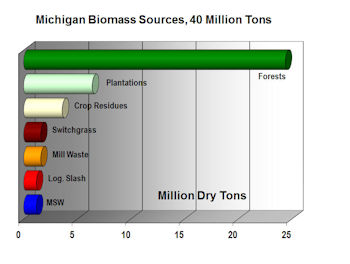
Bar Chart - Michigan
Biomass Sources, 40 Million Tons.
[Source: unpublished data, Ray Miller, MSU Forest Biomass Innovation
Center]
(Click
for larger image)
[Bioeconomy/Spreadsheets/Tons-40million.xls]
Question 10. Which countries have more advanced renewable energy?
Most of them are in northern Europe, and then also in Japan. There are others. Sweden is often held up as the world model for biomass-based energy production. Over half their space heating is done with biomass using district energy and CHP technologies. Sweden now has a few small cities that are now entirely fueled from renewable biomass feedstocks. There are no landfills in Sweden. Their garbage is reused, recycled, or converted to energy.
Renewable Energy Capacities by Country
An At-A-Glance Look at Wind, Solar, Geothermal, and Biofuel Energy Resources
http://www.greenchipstocks.com/articles/renewable-energy-capacities-by-country/765
By Hilary Stingley, Friday, March 12th, 2010
International Energy Agency
http://www.iea.org/country/maps.asp
Information provided by Global Energy's Alternative Energy eTrack allows for a greater understanding of the renewable energy capacities of the global community. Below are the top ten countries' energy capacities, as they correlate to various renewable energy sources. Of course, the capacities will grow over time and country rankings will change, but these 2012 figures provide a general idea of what is happening where.
The United States leads the way in wind power capacity, with Germany and China following not far behind.
Wind Power
1.
United States - 35,296 MW
2. Germany - 25,777 MW
3. China - 25,104 MW
4. Spain - 19,149 MW
5. India - 10,925 MW
6. Italy - 4,850 MW
7. France - 4,492 MW
8. United Kingdom - 4,051 MW
9. Portugal - 3,535 MW
10. Canada - 3,319 MW
Hydro power is most available in China by more than twice the MW of Brazil, the country with the second largest capacity. The United States has the third largest capacity for hydro power.
Hydro Power
1.
China - 179,056 MW
2. Brazil - 81,955 MW
3. United States - 78,054 MW
4. Canada - 75,287 MW
5. Russia - 46,756 MW
6. India - 39,546 MW
7. Norway - 29,317 MW
8. Japan - 22,089 MW
9. France - 20,850 MW
10. Sweden - 16,266 MW
The United States leads the way in wind power capacity, with Germany and China following not far behind.
Wind Power
1.
United States - 35,296 MW
2. Germany - 25,777 MW
3. China - 25,104 MW
4. Spain - 19,149 MW
5. India - 10,925 MW
6. Italy - 4,850 MW
7. France - 4,492 MW
8. United Kingdom - 4,051 MW
9. Portugal - 3,535 MW
10. Canada - 3,319 MW
Germany's capacity for photovoltaic solar power is roughly 6 times larger than that of the U.S. However, the United States still has the largest capacity of concentrated solar power.
Solar (PV) Power
1.
Germany - 6526.00 MW
2. Spain - 5504.76 MW
3. Japan - 2347.00 MW
4. United States - 1487.71 MW
5. Italy - 908.59 MW
6. Republic of Korea - 557.60 MW
7. France - 253.42 MW
8. China - 223.00 MW
9. India - 223.00 MW
10. Australia - 114.39 MW
Solar (CSP) Power
1.
United States - 900.0 MW
2. Spain - 130.0 MW
3. Australia - 37.0 MW
4. Mexico - 25.0 MW
5. Algeria - 20.0 MW
6. Morocco - 20.0 MW
7. Italy - 5.0 MW
8. N/A
9. N/A
10. N/A
The range in capacities for geothermal power as a renewable energy resource is drastic. The United States has roughly 3000 more MWe of geothermal energy available than the Russian Federation, which ranks tenth on the list.
Geothermal Power
1.
United States - 3153.0 MW
2. Philippines - 2195.3 MW
3. Indonesia - 1132.0 MW
4. Mexico - 965.0 MW
5. Italy - 810.0 MW
6. New Zealand - 577.0 MW
7. Japan - 535.0 MW
8. Kenya - 169.0 MW
9. Turkey - 83.0 MW
10. Russian Federation - 81.0 MW
Germany has by far the largest capacity for energy available from biogas, a type of biofuel that can be used as a low-cost fuel for any heating purpose. When compressed, biogas can also be used to power motor vehicles. In the UK alone, biogas is estimated to have the potential to replace 17% of vehicle fuel.
Biogas Power
1.
Germany - 3,594 MW
2. United Kingdom - 1,425 MW
3. United States - 1,047 MW
4. Italy - 477 MW
5. Australia - 427 MW
6. Spain - 194 MW
7. Netherlands - 130 MW
8. France - 120 MW
9. Canada - 117 MW
10. Sweden - 64 MW
Biomass energy, derived from living or recently living organisms, is most heavily available in the United States. Several countries have large capacities for biomass as a renewable energy resource.
Biomass Power
1.
United States - 9,391 MW
2. Germany - 5,890 MW
3. Sweden - 4,522 MW
4. Brazil - 3,970 MW
5. Japan - 2,834 MW
6. Netherlands - 2,531 MW
7. China - 2,381 MW
8. Finland - 2,352 MW
9. India - 2,117 MW
10. Canada - 1,885 MW
Keep in mind the energy consumption in each of the above countries. These megawatt values are comparatively quite small.
Spreadsheet: Bioeconomy/Spreadsheets/RenewableByCountry.xls
Globally, about 2.1% (2005, EIA) of generated electricity comes from renewables
Renewables = Geothermal, Solar, Wind, and Wood & Waste
· EIA 2006 Top ten countries in total GSWWW are: USA, Germany, Japan, Spain, Italy, Philippines, Brazil, Mexico, UK, Indonesia
· EIA 2005 Top ten countries in hydro power: China, Canada, Brazil, USA, Russia, Norway, India, Japan, Venezuela, Sweden
· EIA 2005 Top ten countries in nuclear power: USA, France, Japan, Germany, Russia, South Korea, Canada, Ukraine, UK, Sweden
· EIA 2005 Top ten countries in conventional thermal power: USA, China, Japan, Russia, India, Germany, UK, Italy, S.Korea, S.Africa
Spreadsheet: Bioeconomy/Spreadsheets/RenewableByCountry.xls
 |
This website was developed and created by Michigan State University Extension for the teachers of the State of Michigan. |
Page Name: 1-BigEnergy.htm